 Be Inspired Blog - Arizona
Be Inspired Blog - Arizona

How to Grow Camellias in the Valley
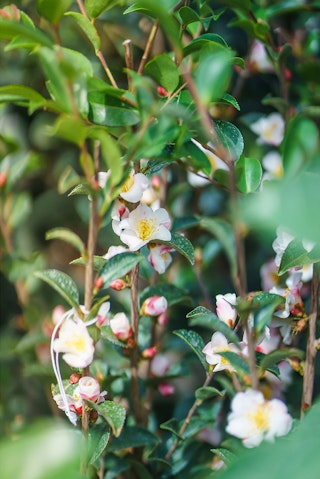 Known for their glossy evergreen leaves and vibrant blooms, camellias can thrive even in the desert climate of the greater metro Phoenix area with the right care. Varieties such as Camellia japonica and Camellia sasanqua are common, while hybrids are bred for attributes like improved cold tolerance or unique growth forms. While camellias can be fairly low-maintenance once established, they require careful planning and attention to grow well in our desert.
Known for their glossy evergreen leaves and vibrant blooms, camellias can thrive even in the desert climate of the greater metro Phoenix area with the right care. Varieties such as Camellia japonica and Camellia sasanqua are common, while hybrids are bred for attributes like improved cold tolerance or unique growth forms. While camellias can be fairly low-maintenance once established, they require careful planning and attention to grow well in our desert.
Selecting the Right Variety
Choosing the right camellia variety is essential for success. In the Valley, Camellia sasanqua starts blooming from mid-fall through early winter, while Camellia japonica flowers later, typically from mid-winter to spring. To enjoy blooms throughout the cooler months, consider planting different varieties with staggered bloom times.
Beyond bloom schedules, camellia varieties offer a range of growth habits. Some are compact, making them ideal for smaller spaces or container gardens, while others have a trailing form that works well for cascading over walls. Spreading varieties are excellent for use as a ground cover or can be trained as an espalier against a fence or wall. Taller camellias, on the other hand, can be used as privacy screens or as part of a layered desert landscape.
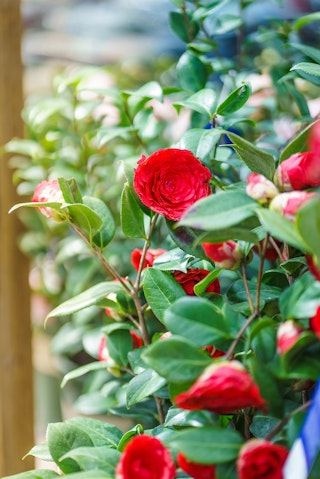
Optimal Growing Conditions
- Hardiness Zone: Camellias typically thrive in zones 7-10, but in the greater metro Phoenix area (Zone 9b and 10a), you'll need to account for our intense summer heat and occasional winter cold snaps. With this in mind, we recommend chosing heat-tolerant varieties and providing them with frost protection when needed.
- Soil: Camellias require slightly acidic soil, ideally with a pH between 5.5 and 6.5. Our desert soils tend to be alkaline, so we recommend amending the soil with organic matter to possibly sulfur to lower the pH. A soil test can help guide this process. We recommend E.B. Stone Organics Azalea, Camellias & Acid Mix as a potting soil or for use as a soil amendment when planting camellias.
- Moisture: Good drainage is crucial. Since camellias don't tolerate waterlogged roots, we recommend planting them in raised beds or containers with well-draining soil. If you choose to plant them in-ground you will want to amend our typical clay desert soil (as stated above) to provide for additional drainage.
- Light: Camellias prefer partial shade, making them a great choice for spots that get morning sun and afternoon shade. In the Valley, they need protection from the intense midday sun. We recommend planting them under taller trees or on the north or east side of a building or your home to avoid sunburn.
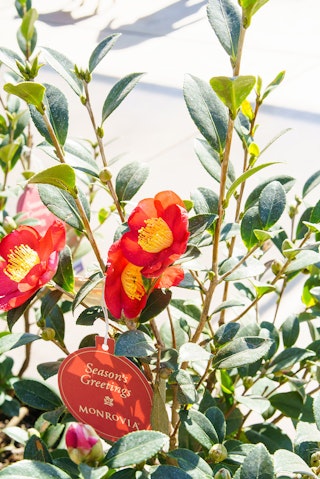
Planting Tips
In the Valley, the ideal time to plant camellias is in early fall or spring, giving them time to establish strong roots before our harsh summer temperatures arrive. To plant, dig a hole twice as wide as the root ball and just as deep. Make sure the root ball sits 2-4 inches above the surrounding soil to avoid planting too deep, which can stress the plant. Surround the root ball with well-draining, acidic soil—such as E.B. Stone Organics Azalea, Camellias & Acid Mix—and cover it lightly with mulch to retain moisture.
Watering
Camellias need regular watering in the first few years after planting, especially during our dry seasons. Once established, they will be more drought-tolerant than when they were young. Even so, they will still require occasional deep watering, especially during our summer heat. To prevent root rot, ensure the soil dries out between waterings.
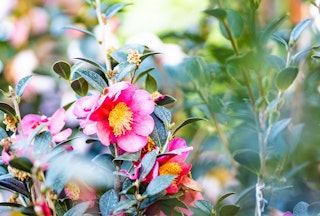
Fertilizing
For the healthiest camellias, use a fertilizer that is formulated for acid-loving plants like camellias or azaleas in the spring after the flowers have fallen. We recommend E.B. Stone Organics Azalea, Camellias & Gardenia Food.
You may fertilize again in mid-summer with an organic fertilizer, such as E.B. Stone Organics Azalea, Camellias & Gardenia Food, if the plant shows signs of stress, such as yellowing leaves or sluggish growth. Always water the plant the day before fertilizing, and avoid fertilizing past August to allow the plant to enter its dormancy period without forcing new growth.
Pruning
After your camellia has finished blooming, prune it to remove dead or weak branches and thin out dense areas to allow better air circulation and light penetration. This helps prevent fungal diseases, which can be a concern in the humid microclimate created by regular watering in the Valley. If you would like your camellias to have a more upright form or denser growth, we recommend pruning the lower branches or cutting back the top to encourage bushiness.
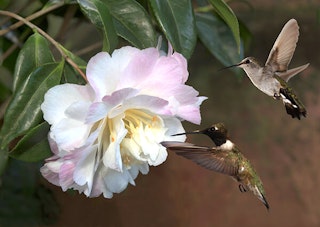 Growing in Containers
Growing in Containers
Camellias can thrive in containers in the Valley, provided they are given enough space to grow and have well-draining soil. A 12- to 14-inch container works for young plants, while more mature camellias may need 16- to 18-inch pots. We recommend using a potting mix that’s rich in organic material, and ensuring the container has sufficient drainage. Place your camellias in a location that gets morning sun and afternoon shade for best results. Note: plants growing in containers will need additional watering, especially in hotter months.
With thoughtful care and attention to their specific needs, camellias can add a splash of color and elegance to your desert garden, offering year-round greenery and cool-season blooms.
Questions about growing camellias? Stop by your local SummerWinds Nursery and speak with one of our Trusted Garden Advisors today.

